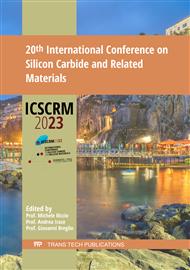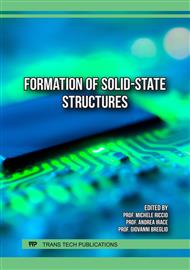[1]
J. A. Cooper & T. Kimoto, Fundamentals of Silicon Carbide Technology (Wiley, Singapore, 2014)
Google Scholar
[2]
B. J. Baliga, Fundamentals of Power Semiconductor Devices 2nd ed. (Springer, Raleigh, 2008)
Google Scholar
[3]
J. Broughton, V. Smet, R. Tummala and Y. Joshi, Review of Thermal Packaging Technologies for Automotive Power Electronics for Traction Purposes (J. Electron. Packag. 2018)
DOI: 10.1115/1.4040828
Google Scholar
[4]
Z. Wei, H. Fu, X. Yan, S. Li, L. Zhang, J. Wei, S. Liu, W. Sun, W. Wu and S. Bai, Influence of Different Device Structures on the Degradation for Trench-Gate SiC MOSFETs: Taking Avalanche Stress as an Example (Materials, 15(2):457, 2022)
DOI: 10.3390/ma15020457
Google Scholar
[5]
M. Sampath, D. Morisette and J. Cooper, A fully self-aligned SiC trench MOSFET with 0.5um channel pitch (ICSCRM 2022 Conference, Davos, 2022)
DOI: 10.4028/p-3gb7i1
Google Scholar
[6]
H. Kitai, H. Shiomi and H. Tamaso, 4H-SiC Vertical Gate Trench with a Well-Controlled Shape Uniformly Formed by High Rate Etching and Annealing with Solid Source (International Conference on Solid State Devices and Materials, Sapporo, 2015)
DOI: 10.7567/ssdm.2015.j-2-2
Google Scholar
[7]
Y. Kawada, T. Tawara and S. Nakamura, Technology for Controlling Trench Shape in SiC Power MOSFETs (Fuji Electric review, Tokyo, 2009)
Google Scholar
[8]
A. Croot, C. Bolton, K. Riddell, H. Ashraf, B. Jones, F. Monaghan, J. Mitchell, M. R. Jennings and O. J. Guy, Rounded Base Corners in SiC Trenches for Power MOSFETs (CS MANTECH Conference, Monterey, 2021)
Google Scholar
[9]
H. Ashraf, A. Croot and K. Riddell, US Patent No. 20210175082A1 (2021)
Google Scholar
[10]
A. Padovani, D. Z. Gao, A. L. Shluger and L. Larcher, A Microscopic Mechanism of Dielectric Breakdown in SiO2 Films: An Insight from Multi-Scale Modeling (Journal of Applied Physics, 2012)
DOI: 10.1063/1.4979915
Google Scholar
[11]
M. Usman and A. Hallén, Radiation-Hard Dielectrics for 4H–SiC: A Comparison Between SiO2 and Al2O3 (IEEE Electron Device Letters, 2011)
DOI: 10.1109/led.2011.2166992
Google Scholar
[12]
S. M. Thomas, M. R. Jennings, Y. K. Sharma, C. A. Fisher and P. A. Mawby, Impact of the Oxidation temperature on the Interface Trap Density in 4HSiC MOS Capacitors (Materials Science Forum, 2014)
DOI: 10.4028/www.scientific.net/msf.778-780.599
Google Scholar
[13]
G. Liu et al. Effects and Mechanisms of RIE on SiC Inversion Layer Mobility and its Recovery (Applied Surface Science, 2015)
Google Scholar
[14]
S. M. Thomas, M. R. Jennings, Y. K. Sharma, C. A. Fisher, P. A. Mawby, Impact of the Oxidation Temperature on the Interface Trap Density in 4HSiC MOS Capacitors (Materials Science Forum, 2014)
DOI: 10.4028/www.scientific.net/msf.778-780.599
Google Scholar
[15]
M. R. Jennings et al. On the Ti3SiC2 Metallic Phase Formation for Robust P-Type 4H-SiC Ohmic Contacts (Materials Science Forum, 2014)
Google Scholar



